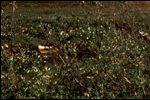
| Home
Mission 2007 Team Information Research Topics Sources Progress Journal |
|
INFLUENTIAL LOCAL/STATE GROUPS Summary:
Native groups in Alaska are losing ground in the legislature, but still
have an influential voice because they are a large percentage of the Alaskan
population. The largest ANRC are located in the south and do not have
a direct, vested interest in ANWR. The State Legislature members for
the district that includes ANWR are both democrats and are both interested
in the Native populations in their region. Natives comprise 78% of
the 40-T legislative district. Purpose:
Political ramifications in the state with a decision to drill in ANWR
will be due, vastly, to the reaction of the two Native communities
associated with ANWR. Research into general Native populations and
their political influence was called for. Relevance:
A decision to drill will not have many political ripples on a state
level. Native groups receive money from oil production, as do all Alaskan
citizens, but the opening of ANWR is not a state decision. As discussed
in JURISDICTION - STATE/FEDERAL because ANWR is federal land
the U.S. Senate has the power to decide what occurs on the land. Native groups' influence
in Alaska is a multifaceted issue. Native Alaskans comprise 15.6%
of the Alaskan population. This percentage allows them more influence
than other Native populations throughout the country. Within the state,
though, their sway has been declining. The urban population of Alaska
continues to grow and out numbers the Native population by more every year.
This growth has led to redistricting of the legislative districts.
The North Slope borough and adjacent Northwest Arctic borough are only
represented by one senator and two representatives. When Alaska gained
statehood this area accounted for 25% of the legislative representation.
The major populous areas in Alaska are Anchorage, Fairbanks, Juneau,
Sitka, and Ketchikan, which are all in the south. "Alaska -- American
Indian Area and Alaska Native Area" contains statistics of the population
and population densities within Native corporations and other geographical
dividers. "Census 2000 Block Map: North Slope Borough" shows
the lack of population in the Prudhoe Bay area. This has two implications:
one, opening ANWR for drilling would not create a populous within
ANWR, and, two, because there aren't any people in this area there is a
lack of representation the Legislature. The Native corporations
formed by ANCSA have allowed Alaska Natives to gain politically, but they
still aren't where they would like to be with regards to social policy.
Reed Stoops, quoted in "Political clout", says "Because they're business
corporations, they're likely to have more influence on business issues than
social issues." Alaska Native Regional Corporations (ANRC) have different
amounts of power depending on the size of their corporations, much like
any other business entity. The largest ANRCs are Cook Inlet (near
Anchorage), Calista (west of Anchorage on the Bering Sea), and Sealaska (the
panhandle). The Legislative
district that encompasses ANWR is 40-T. Its representative is Reggie
Joule and its senator is Donald Olson. Both are democrats, which in
a state where republicans have been the majority for many years is a noteworthy
fact. Joule takes special personal interest in native sports and serves
on the non-governmental World Eskimo-Indian Olympics Board. Olson is
an accomplished doctor, pilot, and businessman. Sources: "Alaska
-- American Indian Area and Alaska Native Area." U.S. Census Bureau.
Online. "Amended
Final Plan Population Analysis." Alaska Redistricting Board. Online.
16 Oct. 03. http://www.state.ak.us/redistricting/am_amendedfinal.htm "Amended
Final Redistricting Plan." Alaska Redistricting Board. Online.
16 Oct. 03. http://www.state.ak.us/redistricting/am_amendedfinal.htm "American Indians and Alaska Natives in Alaska." U.S. Census Bureau. Online. 16 Oct. 03. http://ftp2.census.gov/geo/maps/special/aian_wall/aian_ak.pdf "Census
2000: Alaska Profile." U.S. Census Bureau. Online. 16
Oct. 03. http://ftp2.census.gov/geo/maps/special/profile2k/AK_2K_Profile.pdf
"Census
2000 Block Map: North Slope Borough." U.S. Census Bureau. Online.
16 Oct. 03. http://ftp2.census.gov/geo/maps/blk2000/st02_Alaska/County/02185_NorthSlope/ "General Demographic Characteristics." U.S. Census Bureau. Online. 16 Oct. 03. http://www.census.gov/census2000/states/ak.htm Holst,
Svend. "Political clout." The Juneau Empire. JuneauAlaska.com
Online. 10 Nov. 03. http://juneaualaska.com/between/political.shtml "Representative
Reggie Joule - Biographical Sketch." Alaska Legislature Home Page.
Online. 10 Nov. 03. http://w3.legis.state.ak.us/hous/23/JOU.htm "Representative
Richard Foster - Biographical Sketch." Alaska Legislature Home Page.
Online. 10 Nov. 03. http://w3.legis.state.ak.us/hous/23/FOS.htm "Senator
Donald Olson." Alaska Legislature Home Page. Online. 10
Nov. 03. http://w3.legis.state.ak.us/senate/23/OLS.htm "23rd Alaska
State Legislature by District." Alaska Legislature Home Page. Online.
16 Oct. 03. http://w3.legis.state.ak.us/legdist/23/legdist23.htm |



| Last updated: 10 Nov.
03 20:27 Page Layout: Mariela Perignon |
Kat Vater - kvater@mit.edu Team 9 - m2007-9@mit.edu |